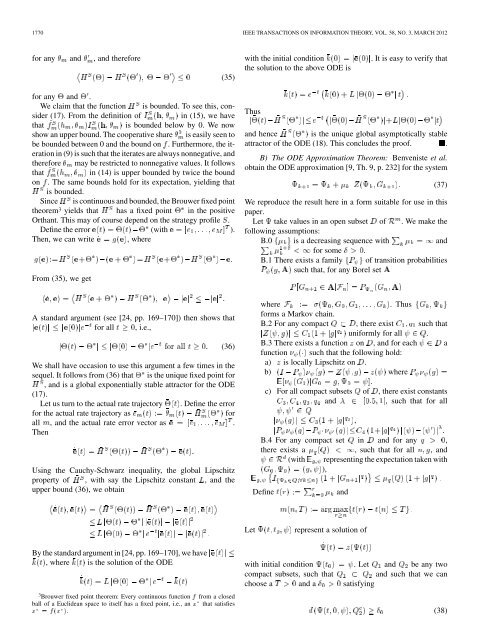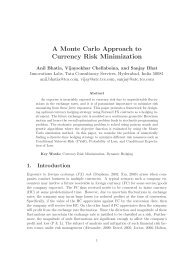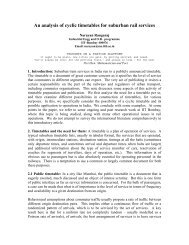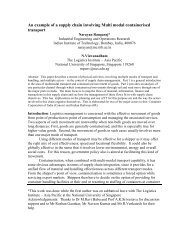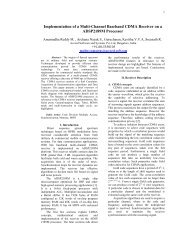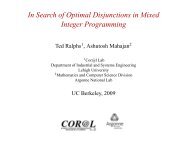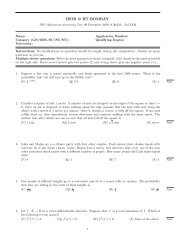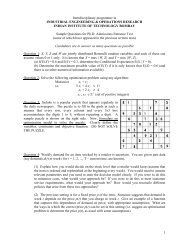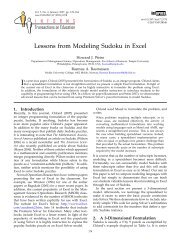Opportunistic Scheduling in Cellular Systems in the Presence of ...
Opportunistic Scheduling in Cellular Systems in the Presence of ...
Opportunistic Scheduling in Cellular Systems in the Presence of ...
Create successful ePaper yourself
Turn your PDF publications into a flip-book with our unique Google optimized e-Paper software.
1770 IEEE TRANSACTIONS ON INFORMATION THEORY, VOL. 58, NO. 3, MARCH 2012<br />
for any and , and <strong>the</strong>refore<br />
(35)<br />
with <strong>the</strong> <strong>in</strong>itial condition<br />
<strong>the</strong> solution to <strong>the</strong> above ODE is<br />
. It is easy to verify that<br />
for any and .<br />
We claim that <strong>the</strong> function is bounded. To see this, consider<br />
(17). From <strong>the</strong> def<strong>in</strong>ition <strong>of</strong> <strong>in</strong> (15), we have<br />
that<br />
is bounded below by 0. We now<br />
show an upper bound. The cooperative share is easily seen to<br />
be bounded between 0 and <strong>the</strong> bound on . Fur<strong>the</strong>rmore, <strong>the</strong> iteration<br />
<strong>in</strong> (9) is such that <strong>the</strong> iterates are always nonnegative, and<br />
<strong>the</strong>refore may be restricted to nonnegative values. It follows<br />
that<br />
<strong>in</strong> (14) is upper bounded by twice <strong>the</strong> bound<br />
on . The same bounds hold for its expectation, yield<strong>in</strong>g that<br />
is bounded.<br />
S<strong>in</strong>ce is cont<strong>in</strong>uous and bounded, <strong>the</strong> Brouwer fixed po<strong>in</strong>t<br />
<strong>the</strong>orem 3 yields that has a fixed po<strong>in</strong>t <strong>in</strong> <strong>the</strong> positive<br />
Orthant. This may <strong>of</strong> course depend on <strong>the</strong> strategy pr<strong>of</strong>ile .<br />
Def<strong>in</strong>e <strong>the</strong> error (with ).<br />
Then, we can write , where<br />
From (35), we get<br />
Thus<br />
and hence is <strong>the</strong> unique global asymptotically stable<br />
attractor <strong>of</strong> <strong>the</strong> ODE (18). This concludes <strong>the</strong> pro<strong>of</strong>. .<br />
B) The ODE Approximation Theorem: Benveniste et al.<br />
obta<strong>in</strong> <strong>the</strong> ODE approximation [9, Th. 9, p. 232] for <strong>the</strong> system<br />
(37)<br />
We reproduce <strong>the</strong> result here <strong>in</strong> a form suitable for use <strong>in</strong> this<br />
paper.<br />
Let take values <strong>in</strong> an open subset <strong>of</strong> . We make <strong>the</strong><br />
follow<strong>in</strong>g assumptions:<br />
B.0 is a decreas<strong>in</strong>g sequence with and<br />
for some .<br />
B.1 There exists a family <strong>of</strong> transition probabilities<br />
such that, for any Borel set<br />
A standard argument (see [24, pp. 169–170]) <strong>the</strong>n shows that<br />
for all , i.e.,<br />
(36)<br />
We shall have occasion to use this argument a few times <strong>in</strong> <strong>the</strong><br />
sequel. It follows from (36) that is <strong>the</strong> unique fixed po<strong>in</strong>t for<br />
, and is a global exponentially stable attractor for <strong>the</strong> ODE<br />
(17).<br />
Let us turn to <strong>the</strong> actual rate trajectory . Def<strong>in</strong>e <strong>the</strong> error<br />
for <strong>the</strong> actual rate trajectory as<br />
for<br />
all , and <strong>the</strong> actual rate error vector as .<br />
Then<br />
Us<strong>in</strong>g <strong>the</strong> Cauchy-Schwarz <strong>in</strong>equality, <strong>the</strong> global Lipschitz<br />
property <strong>of</strong> , with say <strong>the</strong> Lipschitz constant , and <strong>the</strong><br />
upper bound (36), we obta<strong>in</strong><br />
where<br />
. Thus<br />
forms a Markov cha<strong>in</strong>.<br />
B.2 For any compact , <strong>the</strong>re exist such that<br />
uniformly for all .<br />
B.3 There exists a function on , and for each a<br />
function such that <strong>the</strong> follow<strong>in</strong>g hold:<br />
a) is locally Lipschitz on .<br />
b) where<br />
.<br />
c) For all compact subsets <strong>of</strong> , <strong>the</strong>re exist constants<br />
and<br />
, such that for all<br />
,<br />
.<br />
B.4 For any compact set <strong>in</strong> and for any ,<br />
<strong>the</strong>re exists a , such that for all , and<br />
(with represent<strong>in</strong>g <strong>the</strong> expectation taken with<br />
),<br />
Def<strong>in</strong>e<br />
and<br />
Let<br />
represent a solution <strong>of</strong><br />
By <strong>the</strong> standard argument <strong>in</strong> [24, pp. 169–170], we have<br />
, where is <strong>the</strong> solution <strong>of</strong> <strong>the</strong> ODE<br />
3 Brouwer fixed po<strong>in</strong>t <strong>the</strong>orem: Every cont<strong>in</strong>uous function f from a closed<br />
ball <strong>of</strong> a Euclidean space to itself has a fixed po<strong>in</strong>t, i.e., an x that satisfies<br />
x = f (x ).<br />
with <strong>in</strong>itial condition . Let and be any two<br />
compact subsets, such that<br />
and such that we can<br />
choose a and a satisfy<strong>in</strong>g<br />
(38)


